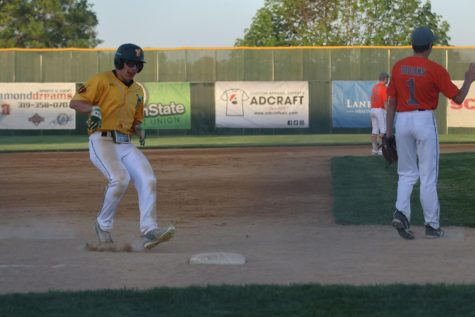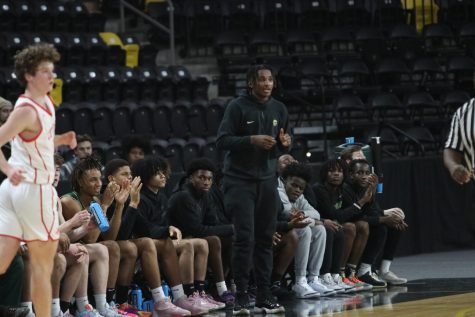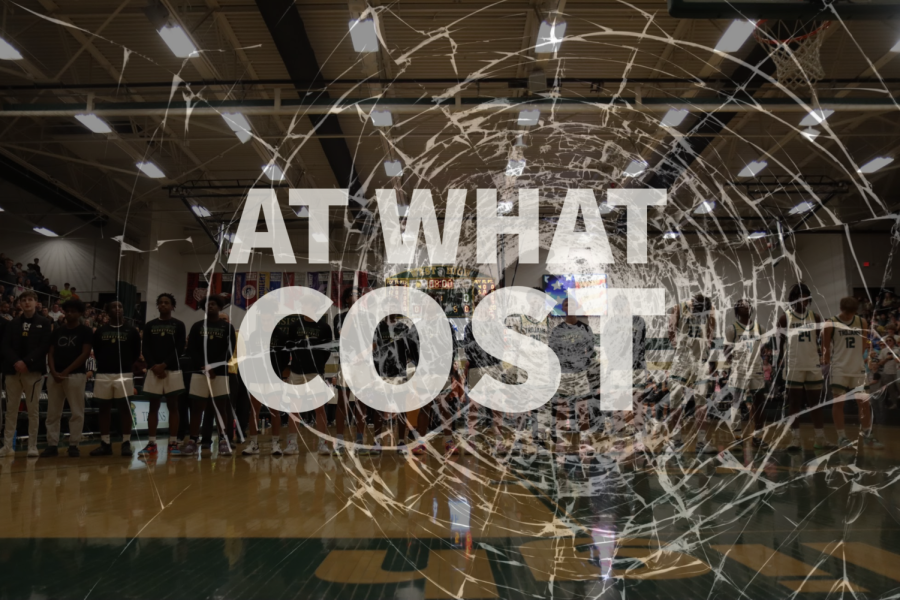At what cost
From ACL tears to concussions, sports are filled with the risk of injury. What may seem like a few weeks on the bench, can become a lifelong issue.
The boy’s basketball team stands behind broken glass.
One moment a player is on the field, running, jumping, cheering and scoring goals. For many teenage athletes, that next layup, next tackle, next shot or next hurdle could be their last. The risk of injury is high with any physical activity, but being injured as an adolescent when your body is still growing can have hidden detrimental effects.
There are more than 4 million high school athletes in America, and according to the Centers for Disease Control, more than 2 million of them will be injured in some way during their high school careers. Whether it is a minor ankle sprain or a major concussion, athletes have to sit out for at least a few days before returning to activity, and a few days can seem like a lifetime for a teenager’s high school career.
Ryne Vander Leest ʼ23 was not expecting to end his sophomore year with an injury that would land him on the bench for the rest of the baseball season and postseason. After getting hit in the mouth with a baseball on first base, Vander Leest received stitches and later reconstructive surgery to save the teeth hit by the baseball. Although he had a long recovery of resting, waiting, and a few operations, he explains that an unfortunate part of the recovery process was his time spent on the bench, unable to help the rest of his team.

“It was really hard just because you feel like you can [play] physically and you’re not able to, and especially during the playoffs, you want to do everything possible to help your team out,” said Vander Leest.
Junior Kareem Earl had similar experiences when dealing with a back injury this past season. Earl is a starter on the West High basketball team and has led them to many wins over his past seasons with the Trojans. But this year’s season came to a halt when he had to take a step off the court for six weeks due to a back injury.
It was difficult for him to be on the sidelines watching his team, but he knew that if he didn’t take that step back, he could be on the bench for much longer. But the importance of resting your body post-injury is vital.

“During adolescence, the muscles and ligaments cannot keep pace with the bone growth and their bone density does not reach its peak until the early 20s. Therefore, high school athletes are more susceptible to bone-related injuries.” says the National Foundation for High School Associations.
“It was hard getting back into the game, like my cardio and stuff, but I love basketball so I did it,” Earl said, describing some of the difficulties he faced returning to the court.
But without the rest and recovery period that Earl had, he could’ve broken his back and damaged it even further, putting him out for more than 6-weeks.
These are not uncommon stories. Throughout West High, student-athletes are struggling to make decisions about what is best for them and their health as they move through high school. Dr. Brian Wolf M.D., M.S. is an orthopedic surgeon that specializes in sports medicine at the University of Iowa and can also be found on the sidelines at many West High and University of Iowa sporting events, helping out the athletes.
Wolf explains the complexities of making a decision regarding a high school career, and that the long-term impacts that may result are based on the fine details of the injury itself.
“With common things like let’s say a knee injury, a lot of their prognosis for down the road depends on what all was damaged. If they tore their ACL but everything else in their knee was good…[their prognosis] down the road is actually pretty good,” Wolf said. “If it’s something where they have damaged meniscus or cartilage or other things that have a harder time healing…then the chances of them having some trouble with their knee or joint down the road goes up a little bit.”
While an athlete might not have serious damage, or damage requiring a long recovery time, the risk continues to increase with every reinjury.
“Fortunately, the vast majority of people that get a concussion don’t have issues later. So the people that seem to run into trouble with having concussion issues down the road are people that probably had multiple hits to their head, [like] people that played football for a long time,” Wolf explained.
CTE or Chronic traumatic encephalopathy is common in football players that usually go on to play professionally and sustain multiple blows to the head. It can also increase your risk of Parkinson’s disease, Dementia and Alzheimer’s.
Injuries are prevalent in any sport at any level, but here at West, Wolf and the UI Sports Medicine team as well as athletic trainer Sheila Stiles have worked together to integrate injury prevention steps into the lives of student-athletes. Warm-up routines and testing for the basketball teams, and shoulder flexibility programs for the baseball teams are just two of the preventative measures used by West High student-athletes. As athletes continue their sport at a collegiate level, more and more programs are used to decrease the risk of injury.
Wolf continues to explain that generally, these programs are pretty easy to do. The hardest part is that it just takes a little bit of time and commitment. But athletes who love and work hard at their sports day in and day out know what commitment means and work hard to get back on the field.
Injuries may put athletes out of the game for a short period of time, but Wolf thinks getting back to playing is super important, and being scared of injury should not halt any student-athlete from lacing up those cleats again.
“I do think that the benefits of sports usually outweigh the risks that people take to participate. even though I’ve seen kind of all the bad things that happen, I think I’m still on the side of I think sports are good, and I think they’re healthy for people,” said Wolf.
Your donation will support the student journalists of West High School. Your contribution will allow us to purchase Scholarship Yearbooks, newsroom equipment and cover our annual website hosting costs.

(she/her) Zoe Smith is a senior and entering her third and final year on staff. She is so excited to be this year's Web Editor-in-Chief. Although you can...

Ashlyn is a senior and she is the Online Editor-in-Chief. When she's not in the newsroom, you can find her binge-watching any 2000s tv show, curled up...



